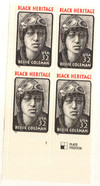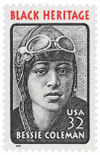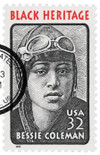
# 2956 - 1995 32c Black Heritage: Bessie Coleman
U.S. #2956
1995 32¢ Bessie Coleman
Black Heritage Series
- 18th stamp in the Black Heritage Series; fifth honoring a woman
- Honors Bessie Coleman the first female African American aviator
Stamp Category: Commemorative
Series: Black Heritage Series
Value: 32¢, rate for first-class mail
First Day of Issue: April 27, 1995
First Day City: Chicago, Illinois
Quantity Issued: 97,000,000
Printed by: Bureau of Engraving and Printing
Printing Method: Engraved
Format: Panes of 50 in sheets of 200
Perforations: 11.2
Why the stamp was issued: To honor the life of aviator Bessie Coleman. This stamp was the result of a years-long campaign led by the aviator’s niece, Marion Coleman. Coleman worked at the USPS for several years and believed her aunt belonged in the Black Heritage Series. After she retired in 1987, Coleman and a group of supporters began writing letters to the USPS requesting a stamp. When the USPS announced they would make the stamp, the story made front page in Chicago (Coleman’s hometown) newspapers.
About the stamp design: This was the second stamp in the Black Heritage Series in which artist Chris Calle strayed from the format of earlier stamps. Rather than picture a portrait and a smaller vignette, it only features a portrait. Calle worked from an original photo of Coleman supplied by the National Air and Space Museum. At the request of the Citizens Stamp Advisory Committee, he made two small changes to make the portrait more informal – unbuckling the chin straps and giving Coleman a slight smile.
Special design details: The background consists of finely engraved loops and curves, which Calle did to give the impression of moving air currents.
First Day City: Midway Airport in Chicago, Illinois – Coleman’s hometown. Normally Black Heritage stamps are issued in February to coincide with Black History Month. But the USPS didn’t get final approval on the 1995 rate change until December 1994, and a stamp couldn’t be completed in that time. So it was released in April at the new rate.
About the Black Heritage Series: The first Black Heritage stamp was issued in 1978 and pictured Harriet Tubman. She was also the first African American woman to be honored on a US stamp. The US Postal Service has continued to issue stamps in this series every year since then.
History the stamp represents: Aviator Elizabeth “Bessie” Coleman was born on January 26, 1892, in Atlanta, Texas. The first female African American aviator, she achieved her dream of becoming a pilot during a time when most African Americans would not have even considered learning to fly.
The tenth of thirteen children, Coleman was born in a one-room cabin to parents of African American and Cherokee ancestry. Her family moved to Waxahachie, Texas when she was two and became sharecroppers. Coleman walked four miles each way to go to school, where she enjoyed reading and math. She attended the Missionary Baptist Church School and spent one term at the Oklahoma Colored Agricultural and Normal University.
In 1915, Coleman moved to Chicago, where some of her brothers lived. Working as a manicurist there, she heard stories from returning World War I pilots and decided she wanted to learn to fly. She got a second job managing a restaurant to raise money for flight school. However, no American flight schools would accept her because she was African American and a woman. Newspaper publisher Robert S. Abbott recommended that she study in Europe and featured her story in his newspaper. The newspaper and banker Jesse Binga then helped fund her trip to France to study at the prestigious Fédération Aéronautique Internationale.
After leaning French, Coleman arrived in Paris on November 20, 1920. She learned to fly the Nieuport 564 and earned her pilot license on June 15, 1921. She was the first black woman and first Native American to earn a pilot’s license. She spent another two months in France taking additional lessons with a French ace pilot before returning to the US. Upon returning home, she realized the best way to making a living would be as a barnstormer, performing dangerous flying stunts. Still, no one in the US would instruct her, so she returned to Europe, getting additional training France, the Netherlands, and Germany.
Coleman returned to America and quickly became a celebrity known for her high-flying acrobatics and pinpoint landings, earning the nicknames “Queen Bess” and “Brave Bessie.” She first performed at a public airshow on September 3, 1922, at an event honoring veterans of the 369th Infantry Regiment. She was billed as “the world’s greatest woman flier.”
Coleman loved the thrill of completing dangerous stunts and the excited reactions from the crowd. She was fearless, and once broke a leg and three ribs when her plane stalled and crashed. Coleman was also a vocal advocate for increased equality in aviation. And she refused to participate in any events that didn’t allow African Americans in the audience. When she was offered a role in a film, she initially accepted, but turned it down when she learned she’d be appearing in torn clothes, because she “had no intention of perpetuating [that] derogatory image.”
Coleman had always wanted to “make something of herself” and one of her major goals was to open a flying school for other African Americans. However, she never got the chance to achieve that goal. On April 30, 1926, she rode as a passenger in a Curtiss JN-4 she had recently purchased. The plane was in poor condition, but she asked her mechanic to fly it so she could scope out the terrain for a parachute jump she had planned for the following day. About 10 minutes into the flight, the plane went into a dive and spin. Coleman was thrown from the plane, which then crashed and exploded. Dying instantly, she was just 34 years old. It was later discovered that a wrench used to fix the engine had been stuck in the controls.
A funeral service was held for Coleman in Florida before she was returned to Chicago, where 10,000 mourners attended a ceremony led by Ida B. Wells. Coleman is the namesake for many buildings, streets, and scholarships around the country. She’s also been inducted into several halls of fame and had a mountain on Pluto named in her honor. Even after her death, she inspired future generations of African American pilots. In Black Wings, author William Powell wrote, “Because of Bessie Coleman, we have overcome that which was much worse than racial barriers. We have overcome the barriers within ourselves and dared to dream.”
U.S. #2956
1995 32¢ Bessie Coleman
Black Heritage Series
- 18th stamp in the Black Heritage Series; fifth honoring a woman
- Honors Bessie Coleman the first female African American aviator
Stamp Category: Commemorative
Series: Black Heritage Series
Value: 32¢, rate for first-class mail
First Day of Issue: April 27, 1995
First Day City: Chicago, Illinois
Quantity Issued: 97,000,000
Printed by: Bureau of Engraving and Printing
Printing Method: Engraved
Format: Panes of 50 in sheets of 200
Perforations: 11.2
Why the stamp was issued: To honor the life of aviator Bessie Coleman. This stamp was the result of a years-long campaign led by the aviator’s niece, Marion Coleman. Coleman worked at the USPS for several years and believed her aunt belonged in the Black Heritage Series. After she retired in 1987, Coleman and a group of supporters began writing letters to the USPS requesting a stamp. When the USPS announced they would make the stamp, the story made front page in Chicago (Coleman’s hometown) newspapers.
About the stamp design: This was the second stamp in the Black Heritage Series in which artist Chris Calle strayed from the format of earlier stamps. Rather than picture a portrait and a smaller vignette, it only features a portrait. Calle worked from an original photo of Coleman supplied by the National Air and Space Museum. At the request of the Citizens Stamp Advisory Committee, he made two small changes to make the portrait more informal – unbuckling the chin straps and giving Coleman a slight smile.
Special design details: The background consists of finely engraved loops and curves, which Calle did to give the impression of moving air currents.
First Day City: Midway Airport in Chicago, Illinois – Coleman’s hometown. Normally Black Heritage stamps are issued in February to coincide with Black History Month. But the USPS didn’t get final approval on the 1995 rate change until December 1994, and a stamp couldn’t be completed in that time. So it was released in April at the new rate.
About the Black Heritage Series: The first Black Heritage stamp was issued in 1978 and pictured Harriet Tubman. She was also the first African American woman to be honored on a US stamp. The US Postal Service has continued to issue stamps in this series every year since then.
History the stamp represents: Aviator Elizabeth “Bessie” Coleman was born on January 26, 1892, in Atlanta, Texas. The first female African American aviator, she achieved her dream of becoming a pilot during a time when most African Americans would not have even considered learning to fly.
The tenth of thirteen children, Coleman was born in a one-room cabin to parents of African American and Cherokee ancestry. Her family moved to Waxahachie, Texas when she was two and became sharecroppers. Coleman walked four miles each way to go to school, where she enjoyed reading and math. She attended the Missionary Baptist Church School and spent one term at the Oklahoma Colored Agricultural and Normal University.
In 1915, Coleman moved to Chicago, where some of her brothers lived. Working as a manicurist there, she heard stories from returning World War I pilots and decided she wanted to learn to fly. She got a second job managing a restaurant to raise money for flight school. However, no American flight schools would accept her because she was African American and a woman. Newspaper publisher Robert S. Abbott recommended that she study in Europe and featured her story in his newspaper. The newspaper and banker Jesse Binga then helped fund her trip to France to study at the prestigious Fédération Aéronautique Internationale.
After leaning French, Coleman arrived in Paris on November 20, 1920. She learned to fly the Nieuport 564 and earned her pilot license on June 15, 1921. She was the first black woman and first Native American to earn a pilot’s license. She spent another two months in France taking additional lessons with a French ace pilot before returning to the US. Upon returning home, she realized the best way to making a living would be as a barnstormer, performing dangerous flying stunts. Still, no one in the US would instruct her, so she returned to Europe, getting additional training France, the Netherlands, and Germany.
Coleman returned to America and quickly became a celebrity known for her high-flying acrobatics and pinpoint landings, earning the nicknames “Queen Bess” and “Brave Bessie.” She first performed at a public airshow on September 3, 1922, at an event honoring veterans of the 369th Infantry Regiment. She was billed as “the world’s greatest woman flier.”
Coleman loved the thrill of completing dangerous stunts and the excited reactions from the crowd. She was fearless, and once broke a leg and three ribs when her plane stalled and crashed. Coleman was also a vocal advocate for increased equality in aviation. And she refused to participate in any events that didn’t allow African Americans in the audience. When she was offered a role in a film, she initially accepted, but turned it down when she learned she’d be appearing in torn clothes, because she “had no intention of perpetuating [that] derogatory image.”
Coleman had always wanted to “make something of herself” and one of her major goals was to open a flying school for other African Americans. However, she never got the chance to achieve that goal. On April 30, 1926, she rode as a passenger in a Curtiss JN-4 she had recently purchased. The plane was in poor condition, but she asked her mechanic to fly it so she could scope out the terrain for a parachute jump she had planned for the following day. About 10 minutes into the flight, the plane went into a dive and spin. Coleman was thrown from the plane, which then crashed and exploded. Dying instantly, she was just 34 years old. It was later discovered that a wrench used to fix the engine had been stuck in the controls.
A funeral service was held for Coleman in Florida before she was returned to Chicago, where 10,000 mourners attended a ceremony led by Ida B. Wells. Coleman is the namesake for many buildings, streets, and scholarships around the country. She’s also been inducted into several halls of fame and had a mountain on Pluto named in her honor. Even after her death, she inspired future generations of African American pilots. In Black Wings, author William Powell wrote, “Because of Bessie Coleman, we have overcome that which was much worse than racial barriers. We have overcome the barriers within ourselves and dared to dream.”








